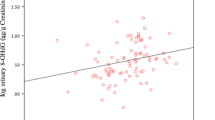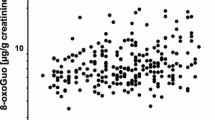Summary
The quantitative analysis of 8-hydroxy-2′-deoxyguanosine (oh8dG) in human peripheral blood cells was carried out to find integrated biomarkers for estimating cancer risk. The change of the oh8dG levels over time in two healthy volunteers was measured to evaluate a intraindividual variance and each individual value was confirmed to be almost constant when they maintained usual life style. We applied this measurement to asbestosis patients who had worked in dockyard for 19–42 years. The oh8dG were detected in all samples and ranged from 0.77 to 1.28/105 deoxyguanosine (dG). No significant differences was observed in mean values of oh8dG between patients (1.00±0.17/105dG) and hospital control group without asbestos exposure (1.03±0.20/105dG) No association was found with the status of cigarette smoking. The oh8dG level in peripheral blood cells is therefore not a sensitive biomarker for past asbestos exposure at low levels.
Similar content being viewed by others
References
Adachi S, Kawamura K, Yoshida S, Takernoto K (1992) Oxidative damage on DNA induced by asbestos and man-made fibers in vitro. Int Arch Occup Environ Health 63: 553–557
Floyd RA, Watson JJ, Wong PK, Altmiller DH, Rickard RC (1986) Hydroxy free radical adducts of deoxyguanosine: sensitive detection and mechanisms of formation. Free Rad Res Commun 1: 163–172
Floyd RA (1990) The role of 8-hydroxyguanine in carcinogenesis. Carcinogenesis 11: 1447–1450
Goodglick LA, Kane AB (1986) Role of reactive oxygen metabolites in crocidolite asbestos toxicity to mouse macrophages. Cancer Res 46: 5558–5566
Gulumian M, Wyk JA Van (1987) Hydroxyl radical production in the presence of fibers by a fenton-type reaction. Chem Biol Interact 62: 89–97
Hansen K, Mossman BT (1987) Generation of superoxide (O2−) from alveolar macrophages exposed to asbestiform and nonfibrous particles. Cancer Res 47: 1681–1686
International Labour Office (1980) Guideline for the use of ILO international classification of radiographs of pneumoconiosis, revised ed. International Labour Office, Geneva
Kasai H, Nishimura S (1984a) Hydroxylation of deoxyguanosine at the C8 position by ascorbic acid and other reducing agents. Nucleic Acid Res 12: 2137–2145
Kasai H, Nishimura S (1984b) DNA damage induced by asbestos in the presence of hydrogen peroxide. Gann 75: 841–844
Kasai H, Crain PF, Kuchino Y, Nishimura S, Ootsuyama A, Tanooka H (1986) Formation of 8-hydroxyguanine moiety in cellular DNA by agents producing oxygen radicals and evidence for its repair. Carcinogenesis 7: 1849–1851
Kasai H, Nishimura S, Kurokawa Y, Hayashi Y (1987) Oral-administration of the renal carcinogen, potassium bromate, specifically produces 8-hydroxydeoxyguanosine in rat target organ DNA. Carcinogenesis 8: 1959–1961
Kasai H, Nishimura S (1991) Formation of 8-hydroxydeoxyguanosine in DNA by oxygen radicals and its biological significance. In: Sies H (ed) Oxydative stress Oxidants and antioxidants. Academic, London, pp 99–116
Kiyosawa H, Murata K, Aota M, Inoue H, Nakazawa K, Kasai H, Nishimura S (1989) Detection of 8-hydroxydeoxyguanosine in human lymphocyte DNA. In: Hayaishi O, Niki E, Kondo M, Yoshikawa T (eds) Medical, biochemical and chemical aspects of free radicals. Elsevier, Amsterdam, pp 1511–1512
Kuchino Y, Mori F, Kasai H, Inoue H, Iwai S, Miura K, Ohtuka E, Nishimura S (1987) Misreading of DNA templates containing 8-hydroxydeoxyguanosine at the modified base and at adjacent residues. Nature 327: 77–79
Leanderson P, Sderkvist P, Tagesson C, Axelson O (1988) Formation of 8-hydroxydeoxyguanosine by asbestos and man made mineral fibres. Br J Ind Med 45: 309–311
Lenanderson P, Tagesson C (1990) Cigarette smoking-induced DNA-damage: role of hydroquinone and catechol in the formation of the oxidative DNA-adduct, 8-hydroxydeoxyguanosine. Chem Biol Interactions 75: 71–81
Richter C, Park JW, Ames BN (1988) Normal oxidative damage to mitochondrial and nuclear DNA is extensive. Proc Natl Acad Sci 85: 6465–6467
Shibutani S, Takeshita M, Grollman AP (1991) Insertion of specific bases during DNA synthesis past the oxidative-damaged base 8-oxodG. Nature 349: 431434
Weizman SA, Graceffa P (1984) Asbestos catalyzes hydroxyl and superoxide radical generation from hydrogen peroxide. Arch Biochem Biophys 228: 373–376
World Health Organization (1986) Asbestos and other natural mineral fibers. (Environmental health criteria 53) World Health Organization, Geneva
Author information
Authors and Affiliations
Rights and permissions
About this article
Cite this article
Hanaoka, T., Tsugane, S., Yamano, Y. et al. Quantitative analysis of S-hydroxyguanine in peripheral blood cells: An application for asbestosis patients. Int. Arch Occup Environ Heath 65 (Suppl 1), S215–5217 (1993). https://doi.org/10.1007/BF00381344
Issue Date:
DOI: https://doi.org/10.1007/BF00381344




